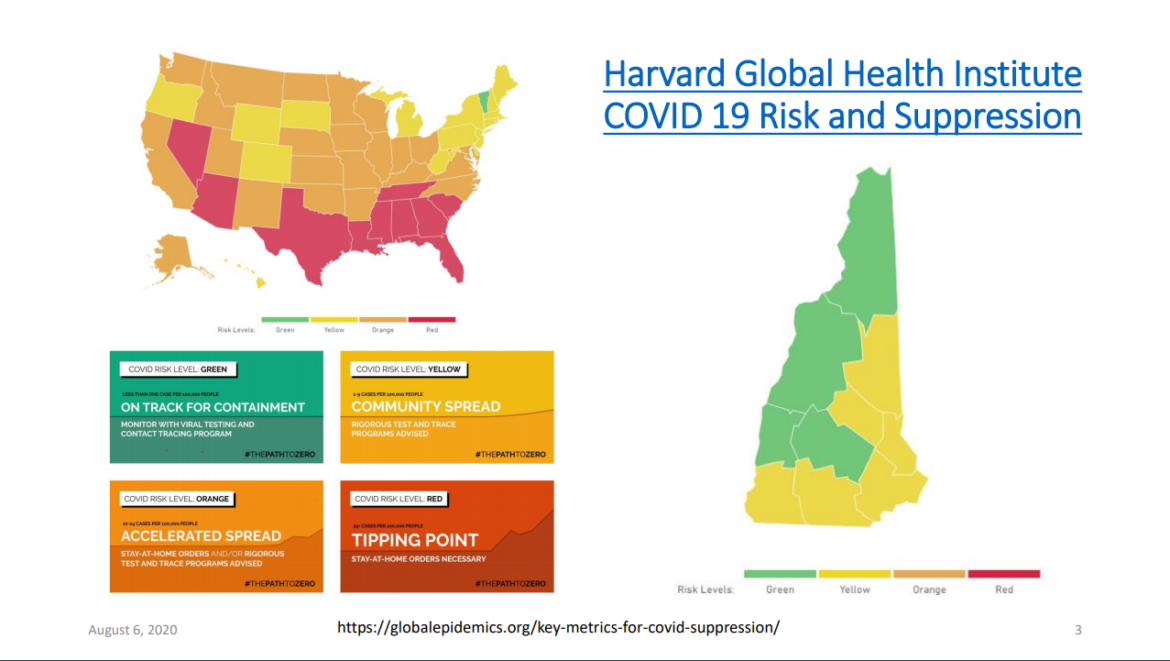By PAULA TRACY, InDepthNH.org
CONCORD – Some areas of New Hampshire are “on track for containment” of COVID-19, particularly in the North and West, Trish Tilley told the Governor’s Economic Reopening Task Force on Thursday.
Tilley, the deputy director of the state Division of Public Health, said the state is seeing a bump up in overall numbers from a few weeks ago but it is not a surge.
The areas where the state is seeing a bump up in new cases are in the south. The largest age cohort getting sick are residents in their 20s, she said.
The Harvard Global Health COVID-19 Risk and Suppression Chart for New Hampshire this week shows that Coos, with no cases, and Grafton, Sullivan, and Merrimack counties are on track for containment of the virus, she said.
A state Department of Health and Human Services chart for this week shows Carroll County has 15 current COVID-19 cases with 4 percent of the state’s total, with Merrimack County having only 2 percent, while Hillsborough County has 50 percent of the state’s total cases.
Currently, the state has 378 active cases and 20 hospitalizations, Tilley said. Since the virus hit the state in March, a total of 698 have been hospitalized, as of Aug. 5.
There are close to 3,000 people now under contact tracing for having contact with someone who developed the new coronavirus, she said.
About 25 percent of those who contracted the virus are health-care workers and they represent about two percent of the deaths.
Those living in long-term care facilities who have contracted the virus represent about 31 percent of the total cases, but 81 percent of the deaths, the chart shows.
About 88 percent of the 6,719 cases are people who have recovered from the illness. And 418 have died.
Tilley told the task force that compared to the rest of the country, New Hampshire and much of New England are looking comparatively safe. Officials are working with counterparts in other states to track New Hampshire residents who become sick there and transfer information about their residents who become sick here.
But she did not have clear information on whether tourists visiting here are infecting residents, but said the state is working on that.
“If you look at the way New England looks compared to the rest of the country, I think many of us are happy to be where we are right now,” said Tilley.
Many parts of the country are seeing surges and while she said New Hampshire has seen an average uptick from a few weeks ago, from averaging 20 new cases a day to now about 30, “we are not yet seeing the fall surge” that is predicted to hit the nation.
She urged people to look at rolling seven-day averages rather than day to day data.
Contact tracing is always important, she said, and New Hampshire has been fortunate to have a robust contact tracing effort “because we have had relatively few numbers we can do a deep dive in that regard.”
“Many of the cases we have seen is often someone with contact with someone in their own house…who is getting sick..It is difficult to put a pinpoint right on tourism but that is a point of our contact tracing,” Tilley told task force members.
The goal of contact tracing is to find out where sick people have been and how people have been exposed, she explained.
Tilley said there have been some cases of restaurants posting they are closing because of COVID-19. She said it is difficult to know exactly who was in that restaurant and said there may be people from other states who infected others there.
Tilley was asked when the state might see an uptick from the NASCAR event last Sunday that drew thousands, many from out of state. She said it would be in the next week or two if there has been an outbreak due to that event.
She acknowledged Motorcycle Week is coming up beginning Aug. 22 and the state is working with Laconia and other areas that host events to work on “strategies for containment.”
“Bike week will look different just as NASCAR did,” Tilley said.
A PowerPoint presentation using data from Aug. 4 and Aug. 5 was used to outline Tilley’s presentation. It can be found here https://www.nheconomy.com/getmedia/cddd25dc-8581-49e0-85f9-b124610c590a/public-health-update-August-6-pdf.pdf
Tilley said by the end of August the state will offer a new dashboard that will allow the public to take a deeper dig into the COVID-19 situation in the state.
The task force also had a briefing from Rich Lavers, deputy commissioner of labor, on the unemployment front.
He said New Hampshire is on a path of steady decline in requests for unemployment assistance since its peak on May 2 and that comparatively, the state is moving faster to reemployment for individuals than the United States as a whole.He offered this PowerPoint. https://www.nheconomy.com/getmedia/49a64d80-872c-4c40-a9e1-42d962583e1f/Updated-Workforce-Slides-8-5-20.pdf





